Differences of Flow Patterns and Pressure Pulsations in Four Prototype Pump-Turbines during Runaway Transient Processes
Abstract
:1. Introduction
2. Three-Dimensional CFD Setups
3. Results of the Runaway Transient Processes
3.1. Macro Parameters Histories
3.2. Radial Velocity Variations and Backflow Transitions at the Runner Inlets
3.3. Pressure Fluctuations in the Time Domain at the Runner Inlets
3.4. Pressure Fluctuations in Time–Frequency Domain at the Runner Inlets
3.5. Flow Patterns in Blade Passage and Draft Tube
4. Discussions of Influences of Runner Shapes
5. Conclusions
Author Contributions
Funding
Acknowledgments
Conflicts of Interest
Nomenclature
| b0 | height of runner inlet (m) |
| Cp | normalized pressure at the runner inlets (-) |
| Cp (O) | original data of normalized pressure at the runner inlets (-) |
| Cp (L) | low-pass filtered data of normalized pressure at the runner inlets (-) |
| Cp (H) | Cp (O) − Cp (L), high frequency data of normalized pressure at the runner inlets (-) |
| D | diameter of the runner inlet (m) |
| E1 | total energy values at the spiral-casing inlet (m) |
| E2 | total energy values at the runner outlet (m) |
| GD2 | Inertia of rotating parts (107 kg · m2) |
| Hr | rated head (m) |
| H | head during the runaway process (m) |
| M | moment during the runaway process (N·m) |
| M0 | moment at the initial time (N·m) |
| M11 | unit torque (N·m) |
| n | rotational speed during the runaway process (rpm) |
| n0 | rotational speed at the initial time (rpm) |
| n1 | rotational speed at the initial time (rad/s) |
| n11 | unit speed (rpm) |
| ns | specific speed (m · kW) |
| nr | rated rotational speed (rpm) |
| Nr | rated output (MW) |
| p | instantaneous pressure (Pa) |
| pinitial | mean initial pressure values at the initial time (Pa) |
| Q | discharge during the runaway process (m3/s) |
| Q0 | discharge at the initial time (m3/s) |
| Q11 | unit discharge (m3/s) |
| t | times (s) |
| u1 | tip velocity of runner blade leading edge (m/s) |
| Ur | the instantaneous radial velocity (m/s) |
| vr | normalized radial velocity at the runner inlets (-) |
| vr (O) | original data of normalized radial velocity at the runner inlets (-) |
| vr (L) | low-pass filtered data of normalized radial velocity at the runner inlets (-) |
| ρ | water density (kg/m3) |
References
- Xia, L.; Cheng, Y.; Yang, Z.; You, J.; Yang, J.; Qian, Z. Evolutions of Pressure Fluctuations and Runner Loads during Runaway Processes of a Pump-Turbine. J. Fluids Eng. Trans. ASME 2017, 139, 091101. [Google Scholar] [CrossRef]
- Fu, X.; Li, D.; Wang, H.; Zhang, G.; Li, Z.; Wei, X. Numerical simulation of the transient flow in a pump-turbine during load rejection process with special emphasis on hydraulic acoustic effect. Renew. Energy 2020, 155, 1127–1138. [Google Scholar] [CrossRef]
- Li, D.; Wang, H.; Xiang, G.; Gong, R.; Wei, X.; Liu, Z. Unsteady simulation and analysis for hump characteristics of a pump turbine model. Renew. Energy 2015, 77, 32–42. [Google Scholar]
- Barbour, E.; Wilson, I.; Radcliffe, J.; Ding, Y.; Li, Y. A review of pumped hydro energy storage development in significant international electricity markets. Renew. Sustain. Energy Rev. 2016, 61, 421–432. [Google Scholar] [CrossRef] [Green Version]
- Durga Hari Kiran, B.; Sailaja Kumari, M. Demand response and pumped hydro storage scheduling for balancing wind power uncertainties: A probabilistic unit commitment approach. Int. J. Electr. Power Energy Syst. 2016, 81, 114–122. [Google Scholar] [CrossRef]
- Cai, J.; Zhou, X.; Deng, L. The research of the abnormal water hammer phenomenon based on the unit 3 over speed test of Jiangsu. Water Power 2009, 35, 87–90. (In Chinese) [Google Scholar]
- Li, Q.; Li, J.; Hu, Q.; Yu, J. Site test on S-shape characteristics of large-sized mixed flow reversible turbine-generator unit. Northwest Hydropower 2012, S1, 81–85. (In Chinese) [Google Scholar]
- Ma, M. Analysis and solution of grid connection failure under low head condition. Mech. Electr. Tech. Hydropower Stn. 2002, 2, 37–39. (In Chinese) [Google Scholar]
- Le, Z.; Kong, L. Cause analysis on rotating part lifting of unit 2 in Tianhuangping pumped storage plant. Mech. Electr. Tech. Hydropower Stn. 2005, 28, 11–13. (In Chinese) [Google Scholar]
- Yang, Z.; Cheng, Y.; Xia, L.; Meng, W.; Gao, L.; Dai, X. Evolutions of guide vane moment of a pump-turbine during runaway transient process after pump trip. IOP Conf. Ser. Earth Environ. Sci. 2019, 240, 072033. [Google Scholar] [CrossRef]
- Li, D.; Fu, X.; Zuo, Z.; Wang, H.; Li, Z.; Liu, S.; Wei, X. Investigation methods for analysis of transient phenomena concerning design and operation of hydraulic-machine systems—A review. Renew. Sustain. Energy Rev. 2019, 101, 26–46. [Google Scholar] [CrossRef]
- Zhang, Y.; Wu, Y. A review of rotating stall in reversible pump turbine. Proc. Inst. Mech. Eng. Part C J. Mech. Eng. Sci. 2017, 231, 1181–1204. [Google Scholar] [CrossRef] [Green Version]
- Zuo, Z.; Liu, S.; Sun, Y.; Wu, Y. Pressure fluctuations in the vaneless space of High-head pump-turbines—A review. Renew. Sustain. Energy Rev. 2015, 41, 965–974. [Google Scholar] [CrossRef]
- Gentner, C.; Sallaberger, M.; Widmer, C.; Braun, O.; Staubli, T. Numerical and experimental analysis of instability phenomena in pump turbines. IOP Conf. Ser. Earth Environ. Sci. 2012, 15, 032042. [Google Scholar] [CrossRef]
- Wang, L.; Yin, J.; Jiao, L.; Wu, D.; Qin, D. Numerical investigation on the “S” characteristics of a reduced pump turbine model. Sci. China Technol. Sci. 2011, 54, 1259–1266. [Google Scholar] [CrossRef]
- Widmer, C.; Staubli, T.; Ledergerber, N. Unstable characteristics and rotating stall in turbine brake operation of pump-turbines. J. Fluids Eng. Trans. ASME 2011, 133, 1–9. [Google Scholar] [CrossRef]
- Hasmatuchi, V.; Farhat, M.; Roth, S.; Botero, F.; Avellan, F. Experimental evidence of rotating stall in a pump-turbine at off-design conditions in generating mode. J. Fluids Eng. Trans. ASME 2011, 133, 1–8. [Google Scholar] [CrossRef]
- Jacquet, C.; Fortes-Patella, R.; Balarac, L.; Houdeline, J.B. CFD investigation of complex phenomena in S-shape region of reversible pump-turbine. IOP Conf. Ser. Earth Environ. Sci. 2016, 49, 042010. [Google Scholar] [CrossRef]
- Trivedi, C.; Cervantes, M.; Gandhi, B. Investigation of a high head Francis turbine at runaway operating conditions. Energies 2016, 9, 149. [Google Scholar] [CrossRef] [Green Version]
- Trivedi, C.; Gandhi, B.; Cervantes, M.; Dahlhaug, O. Experimental investigations of a model Francis turbine during shutdown at synchronous speed. Renew. Energy 2015, 83, 828–836. [Google Scholar] [CrossRef]
- Trivedi, C.; Cervantes, M.; Gandhi, B.; Dahlhaug, O. Transient pressure measurements on a high head model Francis turbine during emergency shutdown, total load rejection, and runaway. J. Fluids Eng. Trans. ASME 2014, 136, 121107. [Google Scholar] [CrossRef]
- Trivedi, C.; Cervantes, M.; Dahlhaug, O.; Gandhi, B. Experimental investigation of a high head Francis turbine during spin-no-load operation. J. Fluids Eng. Trans. ASME 2015, 137, 061106. [Google Scholar] [CrossRef]
- Yin, J.; Wang, D.; Walters, D.; Wei, X. Investigation of the unstable flow phenomenon in a pump turbine. Sci. China Phys. Mech. Astron. 2014, 57, 1119–1127. [Google Scholar] [CrossRef]
- Zhang, X.; Cheng, Y.; Xia, L.; Yang, J.; Qian, Z. Looping dynamic characteristics of a pump-turbine in the s-shaped region during runaway. J. Fluids Eng. Trans. ASME 2016, 138, 1–10. [Google Scholar] [CrossRef]
- Wei, B.; Ji, C. Study on rotor operation stability of high-speed large-capacity generator-motor: The Accident of Rotor Pole in Huizhou Pumped-Storage Power Station. Water Power 2010, 36, 57–60. (In Chinese) [Google Scholar]
- Zhou, Q.; Xia, L.; Zhang, C. Internal mechanism and improvement criteria for the runaway oscillation stability of a pump-turbine. Appl. Sci. 2018, 8, 2193. [Google Scholar] [CrossRef] [Green Version]
- Zhang, X. Three-Dimensional Transient Flow in Pumped-Storage Plant: Simulation and Analysis by Coupling One-Dimensional Water Conveyance System with Three-Dimensional Pump-Turbine. Ph.D. Thesis, Wuhan University, Wuhan, China, 2015. [Google Scholar]
- Zhang, X.; Cheng, Y.; Yang, Z.; Chen, Q.; Liu, D. Influence of rotational inertia on the runner radial forces of a model pump-turbine running away through the S-shaped characteristic region. IET Renew. Power Gener. 2020, 14, 1883–1893. [Google Scholar] [CrossRef]
- Xia, L.; Cheng, Y.; Yang, Z.; Yuan, Y.; Zhu, Z. Numerical investigations into the transient behaviour of a model pump-turbine during load rejection process. IOP Conf. Ser. Earth Environ. Sci. 2019, 240, 072040. [Google Scholar] [CrossRef]
- Liu, Q.; Su, W.; Li, X.; Zhang, Y. Dynamic characteristics of load rejection process in a reversible pump-turbine. Renew. Energy 2020, 146, 1922–1931. [Google Scholar] [CrossRef]
- Yang, Z.; Cheng, Y.; Xia, L.; Meng, W.; Liu, K.; Zhang, X. Evolutions of flow patterns and pressure fluctuations in a prototype pump-turbine during the runaway transient process after pump-trip. Renew. Energy 2020, 152, 1149–1159. [Google Scholar] [CrossRef]
- Fu, X.; Li, D.; Wang, H.; Zhang, G.; Li, Z.; Wei, X. Dynamic instability of a pump-turbine in load rejection transient process. Sci. China Technol. Sci. 2018, 61, 1765–1775. [Google Scholar] [CrossRef]
- Xia, L. Mechanism of the S-Shaped Characteristics and the Flow-Induced Dynamic Instability of Pump-Turbines. Ph.D. Thesis, Wuhan University, Wuhan, China, 2017. [Google Scholar]
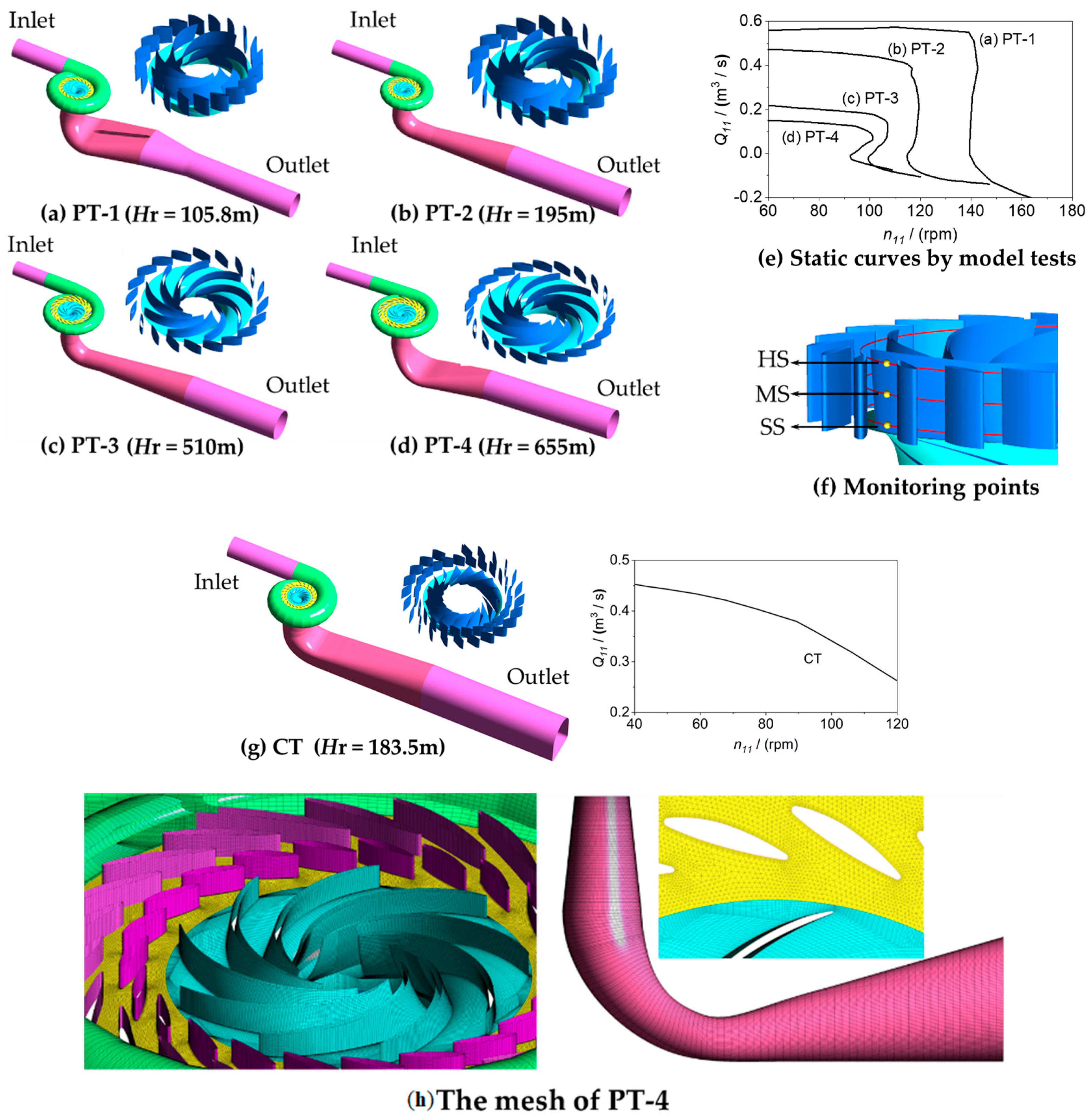
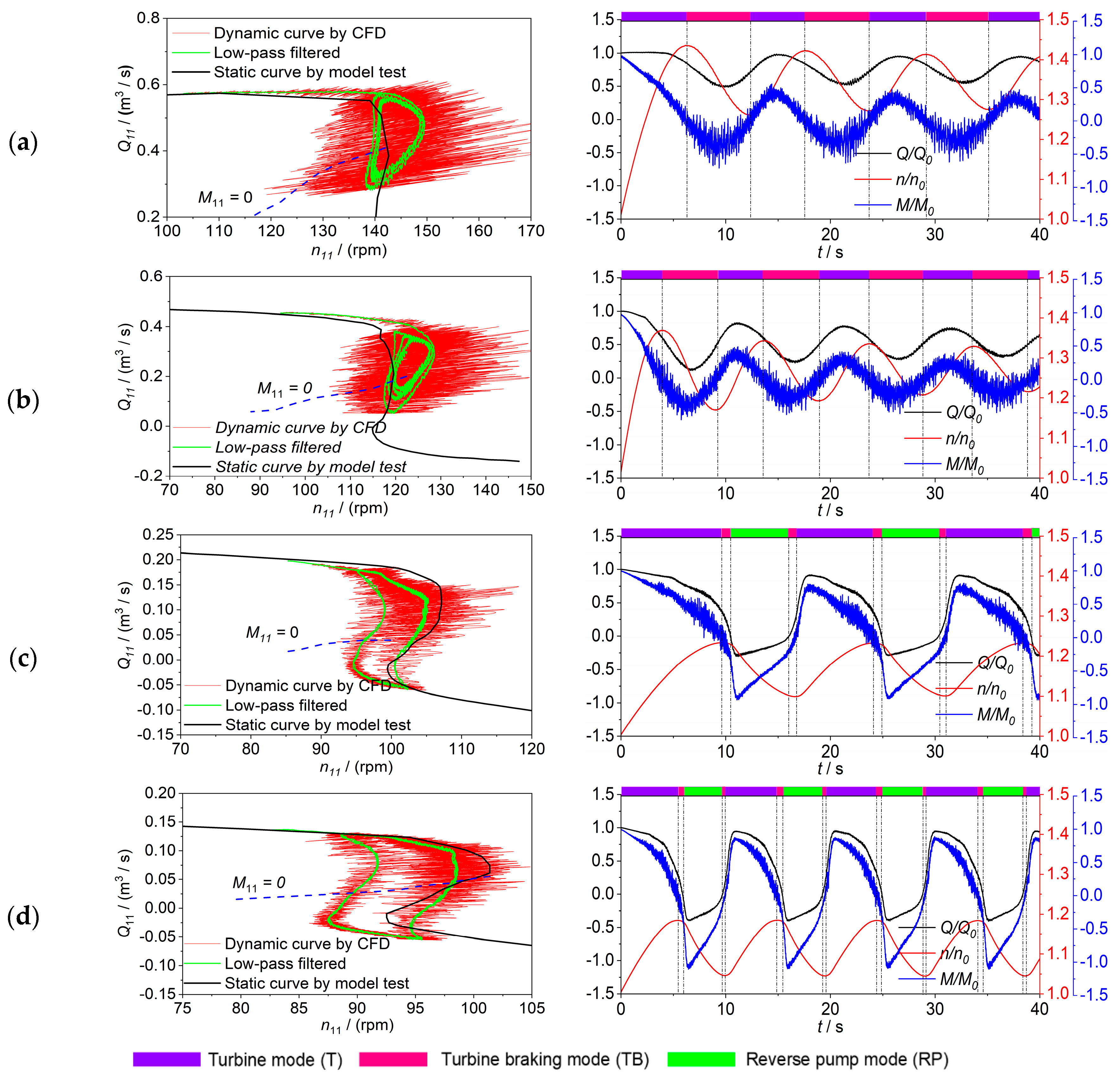





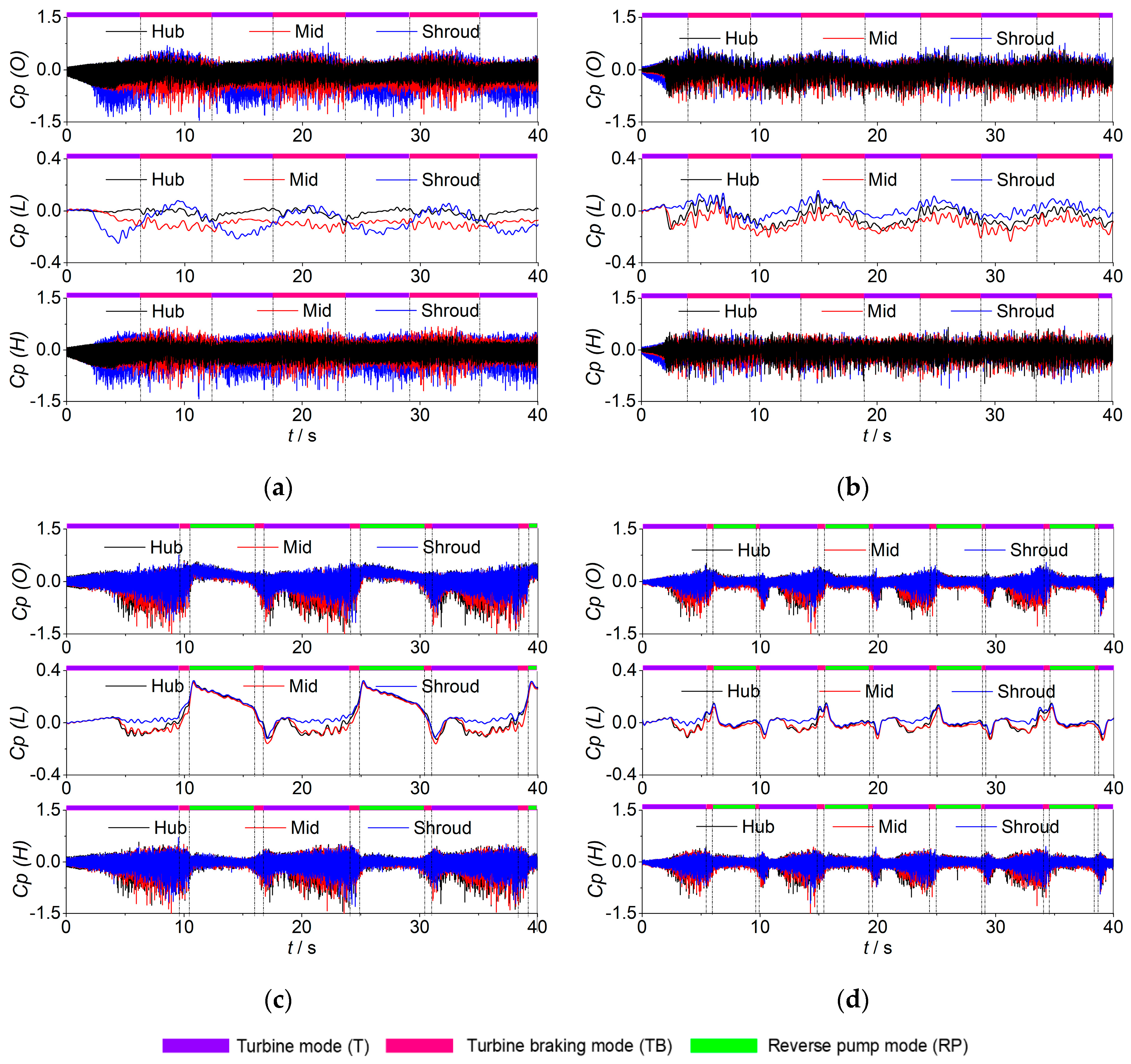












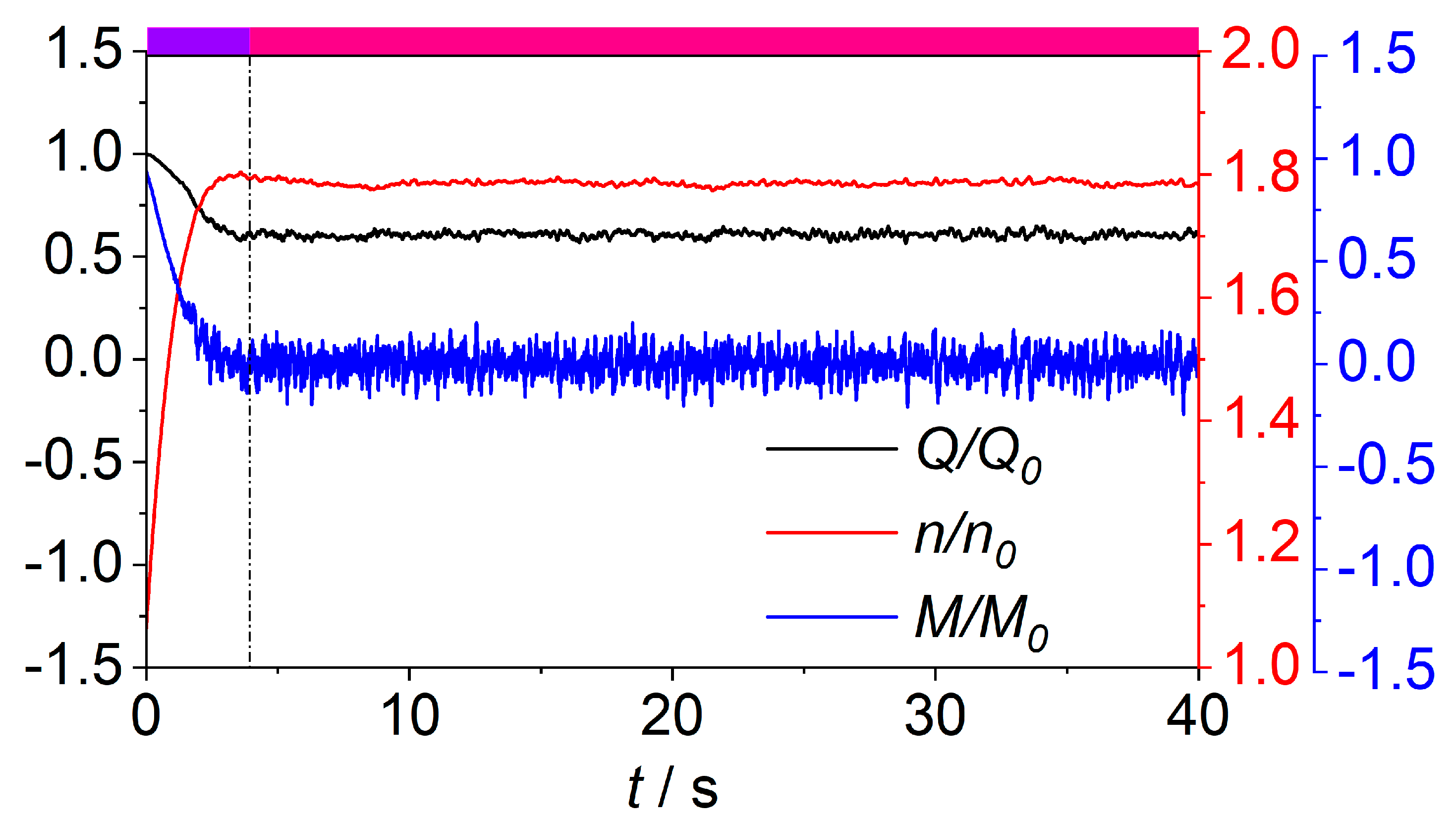
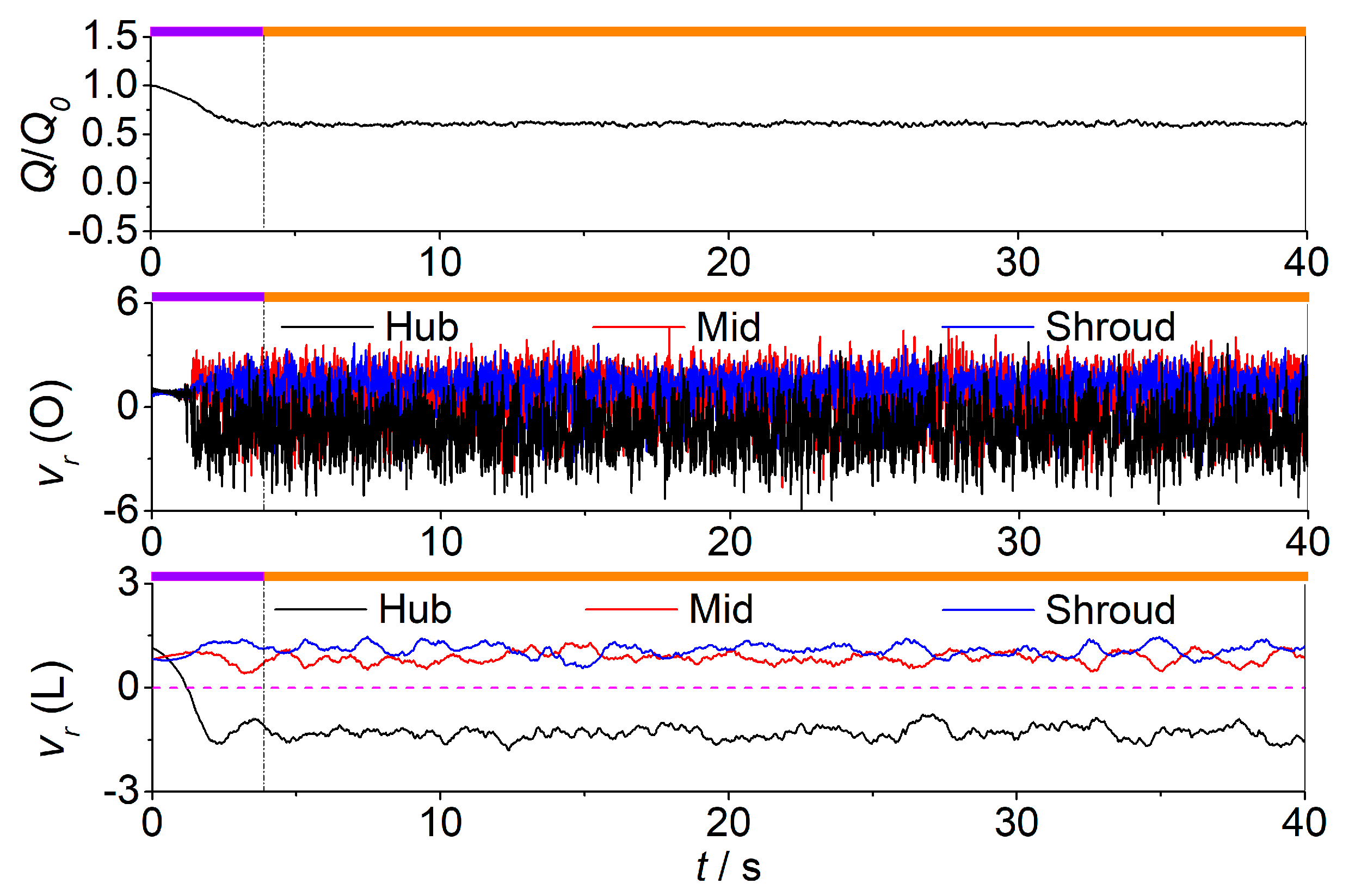

| - | Specific-Speed ns (m·kW) | Rated Head Hr (m) | Rated Output Nr (MW) | Diameter of Runner Inlet D (m) | Height of Runner Inlet b0 (m) | Relative Runner Inlet b0/D (-) | Number of Runner Blades (-) | Inertia of Rotating Parts GD2 (×107 kg·m2) |
|---|---|---|---|---|---|---|---|---|
| PT-1 | 219.8 | 105.8 | 139 | 5.23 | 1.12 | 0.214 | 7 | 1.092 |
| PT-2 | 189.8 | 195.0 | 306 | 5.26 | 0.79 | 0.150 | 9 | 1.092 |
| PT-3 | 114.1 | 510.0 | 306 | 3.82 | 0.34 | 0.089 | 9 | 1.092 |
| PT-4 | 90.2 | 655.0 | 357 | 4.23 | 0.30 | 0.071 | 9 | 1.092 |
| CT | 148.4 | 183.5 | 466 | 6.0 | 1.08 | 0.180 | 16 | 1.092 |
© 2020 by the authors. Licensee MDPI, Basel, Switzerland. This article is an open access article distributed under the terms and conditions of the Creative Commons Attribution (CC BY) license (http://creativecommons.org/licenses/by/4.0/).
Share and Cite
Yang, Z.; Liu, Z.; Cheng, Y.; Zhang, X.; Liu, K.; Xia, L. Differences of Flow Patterns and Pressure Pulsations in Four Prototype Pump-Turbines during Runaway Transient Processes. Energies 2020, 13, 5269. https://doi.org/10.3390/en13205269
Yang Z, Liu Z, Cheng Y, Zhang X, Liu K, Xia L. Differences of Flow Patterns and Pressure Pulsations in Four Prototype Pump-Turbines during Runaway Transient Processes. Energies. 2020; 13(20):5269. https://doi.org/10.3390/en13205269
Chicago/Turabian StyleYang, Zhiyan, Zirui Liu, Yongguang Cheng, Xiaoxi Zhang, Ke Liu, and Linsheng Xia. 2020. "Differences of Flow Patterns and Pressure Pulsations in Four Prototype Pump-Turbines during Runaway Transient Processes" Energies 13, no. 20: 5269. https://doi.org/10.3390/en13205269





